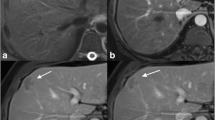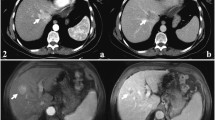Abstract
Purpose
To analyze and compare the differences in MRI features between combined hepatocellular carcinoma-cholangiocarcinoma (cHCC-CCA) and intrahepatic cholangiocarcinoma (iCCA) with arterial phase peripheral enhancement, so as to provide valuable references for preoperative differential diagnosis.
Methods
Seventy cHCC-CCA patients and 74 iCCA patients confirmed by pathology were included in this study. Their contrast-enhanced MRI showed rim arterial phase hyperenhancement (Rim APHE). The differences of clinicopathological data and MRI features between cHCC-CCA and iCCA were compared. Then, the sensitivity, specificity, and area under curve (AUC) were also analyzed and compared.
Results
Seventy cHCC-CCA patients (mean age, 55.7 ± 10.6 years) and 74 iCCA patients (mean age, 61.1 ± 10.5 years) were evaluated. In this study, univariable and multivariable regression analysis showed that AFP > 20 ng/ml (OR = 5.824, p = 0.006), enhancing capsule (OR = 7.252, p = 0.001), and mosaic architecture (OR = 32.732, p < 0.001) were independent risk factors of cHCC-CCA with Rim APHE. However, only hepatic capsule retraction (OR = 0.091, p < 0.001) was an independent predictor of iCCA. In addition, combining AFP > 20 ng/ml with enhancing capsule (96.7% vs. 79.2%, p < 0.001) and/or mosaic architecture (96.4% vs. 94.7%, p < 0.001) can improve the sensitivity of differentiating cHCC-CCA (vs. iCCA) with Rim APHE.
Conclusion
The combination of elevated AFP and MRI features, such as enhancing capsule and mosaic architecture, will help in preoperative differential diagnosis of cHCC-CCA and iCCA with Rim APHE.
Graphical abstract




Similar content being viewed by others
Abbreviations
- AFP:
-
Alpha fetoprotein
- CA19-9:
-
Carbohydrate antigen 19-9
- CCA:
-
Cholangiocarcinoma
- CEA:
-
Carcinoembryonic antigen
- cHCC-CCA:
-
Combined hepatocellular carcinoma-cholangiocarcinoma
- HCC:
-
Hepatocellular carcinoma
- iCCA:
-
Intrahepatic cholangiocarcinoma
- Rim APHE:
-
Rim arterial phase hyperenhancement
References
Sempoux C, Kakar S, Kondo F et al (2019) Combined hepatocellular-cholangiocarcinoma. In: Bosman FT, Carneiro F, Hruban RH, Theise ND, eds. WHO classification of tumours: digestive system tumours. 5th ed. Lyon: IARC:260–262
Sciarra A, ParK Y N, Sempoux C (2020) Updates in the diagnosis of combined hepatocellular-cholangiocarcinoma. Hum Pathol 96:48-55
Zhou C W, Wang Y, Ma L et al (2022) Combined hepatocellular carcinoma-cholangiocarcinoma: MRI features correlated with tumor biomarkers and prognosis. Eur Radiol 32:78-88
Jeon S K, Joo I, Lee D H et al (2019) Combined hepatocellular cholangiocarcinoma: LI-RADS v2017 categorisation for differential diagnosis and prognostication on gadoxetic acid-enhanced MR imaging. Eur Radiol 29:373-382
Brunt E, Aishima S, Clavien PA et al (2018) cHCC-CCA: Consensus terminology for primary liver carcinomas with both hepatocytic and cholangiocytic differentiation. Hepatology 68:113-126
Kim T H, Kim H, Joo I et al (2020) Combined Hepatocellular- Cholangiocarcinoma: Changes in the 2019 World Health Organization Histological Classification System and Potential Impact on Imaging-Based Diagnosis. Korean J Radiol 21:1115-1125
Lee H S, Kim M J, An C (2019) How to utilize LR-M features of the LI-RADS to improve the diagnosis of combined hepatocellular-cholangiocarcinoma on gadoxetate-enhanced MRI?. Eur Radiol 29:2408-2416
Kim M Y, Joo I, Kang H J et al (2020) LI-RADS M (LR-M) criteria and reporting algorithm of v2018: diagnostic values in the assessment of primary liver cancers on gadoxetic acid-enhanced MRI. Abdom Radiol (NY) 45:2440-2448
Chernyak V, Fowler K J, Kamaya A et al (2018) Liver Imaging Reporting and Data System (LI-RADS) Version 2018: Imaging of Hepatocellular Carcinoma in At-Risk Patients. Radiology 289:816-830
Wang Y, Yang Q, Li S et al (2019) Imaging features of combined hepatocellular and cholangiocarcinoma compared with those of hepatocellular carcinoma and intrahepatic cholangiocellular carcinoma in a Chinese population. Clin Radiol 74:e1-407
Hwang J, Kim Y K, Park M J et al (2012) Differentiating combined hepatocellular and cholangiocarcinoma from mass-forming intrahepatic cholangiocarcinoma using gadoxetic acid-enhanced MRI. J Magn Reson Imaging 36:881-889
Jiang H, Song B, Qin Y et al (2021) Diagnosis of LI-RADS M lesions on gadoxetate-enhanced MRI: identifying cholangiocarcinoma-containing tumor with serum markers and imaging features. Eur Radiol 31:3638-3648
Shetty AS, Fowler KJ, Brunt EM, Agarwal S, Narra VR, Menias CO (2014) Combined hepatocellular-cholangiocarcinoma:what the radiologist needs to know about biphenotypic liver carcinoma. Abdom Imaging 39:310-322
Gera S, Ettel M, Acosta-Gonzalez G, Xu R (2017) Clinical features, histology, and histogenesis of combined hepatocellular-cholangiocarcinoma. World J Hepatol 9:300-309
Groeschl R T, Turaga K K, Gamblin T C (2013) Transplantation versus resection for patients with combined hepatocellular carcinoma-cholangiocarcinoma. J Surg Oncol 107:608-612
Yin X, Zhang BH, Qiu SJ et al (2012) Combined hepatocellular carcinoma and cholangiocarcinoma: clinical features, treatment modalities, and prognosis. Ann Surg Oncol 19:2869-2876
Kelley R K, Bridgewater J, Gores G J et al (2020) Systemic therapies for intrahepatic cholangiocarcinoma. J Hepatol 72:353-363
Wang XL, Wang WT, Ma XJ et al (2020) Combined hepatocellular-cholangiocarcinoma: which preoperative clinical data and conventional MRI characteristics have value for the prediction of microvascular invasion and clinical significance? Eur Radiol 30:5337-5347
Kudo A, Matsumura S, Ban D et al (2014) Does the preoperative alpha-fetoprotein predict the recurrence and mortality after hepatectomy for hepatocellular carcinoma without macrovascular invasion in patients with normal liver function? Hepatol Res 44:E437-E446
Xiao Y Y, Zheng X D, Zhou C W et al (2023) Combined hepatocellular carcinoma-cholangiocarcinoma with a predominant HCC component: better survival and MRI-based prediction. Eur Radiol 33:1412-1421
Joo I, Kim H, Lee JM (2015) Cancer stem cells in primary liver cancers: pathological concepts and imaging findings. Korean J Radiol 16:50-68
Bergquist JR, Ivanics T, Storlie CB et al (2016) Implications of CA19-9 elevation for survival, staging, and treatment sequencing in intrahepatic cholangiocarcinoma: a national cohort analysis. J Surg Oncol 114:475-482
Kim S, An C, Han K et al (2019) Gadoxetic acid enhanced magnetic resonance imaging for prediction of the postoperative prognosis of intrahepatic mass-forming cholangiocarcinoma. Abdom Radiol 44:110-121
Park H J, Kim Y K, Park M J et al (2013) Small intrahepatic mass-forming cholangiocarcinoma: target sign on diffusion-weighted imaging for differentiation from hepatocellular carcinoma. Abdom Imaging 38:793-801
Ni T, Shang X S, Wang W T et al (2018) Different MR features for differentiation of intrahepatic mass-forming cholangiocarcinoma from hepatocellular carcinoma according to tumor size. Br J Radiol 91:20180017
Park SH, Lee SS, Yu E et al (2017) Combined hepatocellular-cholangiocarcinoma: gadoxetic acid-enhanced MRI findings correlated with pathologic features and prognosis. J Magn Reson Imaging 46:267-280
Lacomis JM, Baron RL, Oliver JH, Nalesnik MA, Federle MP (1997) Cholangiocarcinoma: delayed CT contrast enhancement patterns. Radiology 203:98-104
Asayama Y, Yoshimitsu K, Irie H et al (2006) Delayed-phase dynamic CT enhancement as a prognostic factor for mass-forming intrahepatic cholangiocarcinoma. Radiology 238:150-155
Funding
This study was supported by National Science Foundation of China (Grant No. 82171897), Clinical Research Plan of SHDC (Grant No. SHDC2020CR1029B), and Science and Technology Commission of Shanghai Municipality (Grant No. 23Y11907400).
Author information
Authors and Affiliations
Contributions
All authors contributed to the study conception and design. Material preparation, data collection and analysis were performed by CZ and PH. The first draft of the manuscript was written by CZ and all authors commented on previous versions of the manuscript. All authors read and approved the final manuscript.
Corresponding authors
Ethics declarations
Conflict of interest
The authors have no relevant financial or non-financial interests to disclose.
Ethical approval
This study was performed in line with the principles of the Declaration of Helsinki. Approval was granted by the Ethics Committee of Zhongshan Hospital, Fudan University.
Consent to participate
Informed consent was obtained from all individual participants included in the study.
Additional information
Publisher's Note
Springer Nature remains neutral with regard to jurisdictional claims in published maps and institutional affiliations.
Supplementary Information
Below is the link to the electronic supplementary material.
Rights and permissions
Springer Nature or its licensor (e.g. a society or other partner) holds exclusive rights to this article under a publishing agreement with the author(s) or other rightsholder(s); author self-archiving of the accepted manuscript version of this article is solely governed by the terms of such publishing agreement and applicable law.
About this article
Cite this article
Zhou, C., Huang, P., Wu, F. et al. How to differentiate between combined hepatocellular carcinoma-cholangiocarcinoma and intrahepatic cholangiocarcinoma with rim arterial phase hyperenhancement?. Abdom Radiol (2024). https://doi.org/10.1007/s00261-024-04194-y
Received:
Revised:
Accepted:
Published:
DOI: https://doi.org/10.1007/s00261-024-04194-y




